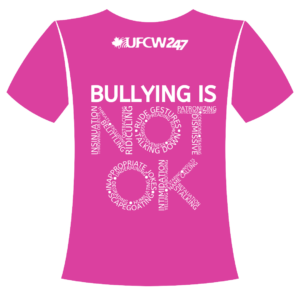Workplace bullying and harassment can take many forms, including verbal abuse, intimidation, exclusion, and unwelcome advances. It creates an atmosphere of fear, anxiety, and diminished morale among employees. No one should have to endure such behavior in the workplace.
In BC, the Workers Compensation Act and the Occupational Health and Safety Regulation require employers to take proactive measures to prevent and address workplace bullying and harassment. These laws outline that Employers, Supervisors and Workers all have the responsibility to not engage in bullying, apply and comply with anti-bullying policies/procedures, as well as report and investigate incidents.
The entire regulation can be viewed here but a summary is available for you below:
“Bullying and Harassment” is defined in the policy as including “any inappropriate conduct or comment by a person towards a worker that the person knew or reasonably ought to have known would cause that worker to be humiliated or intimidated, but excludes any reasonable action taken by an employer or supervisor relating to the management and direction of workers or the place of employment.”
“Conduct or comment” are two terms intended to indicate that a broad spectrum of behaviour is captured in the definition. It includes not just words, but actions, gestures, and other behaviours.
Examples of conduct or comment that might constitute bullying and harassment include, but are not limited to:
-Verbal aggression or insults; calling someone derogatory names
-Vandalizing a worker’s belongings or work equipment
-Sabotaging a person’s work
-Spreading malicious gossip or rumours about a person
-Engaging in harmful or offensive initiation practices
-Physical assault or threats (this would also constitute “violence” or “improper activity or behaviour”)
-Making personal attacks based on someone’s private life and/or personal traits
-Making aggressive or threatening gestures
-Engaging in targeted social isolation
While a number of these examples will involve overt or easily observable behaviours, bullying and harassment can also include more subtle and less obvious conduct or comment. Whether any conduct or comment will constitute bullying and harassment will depend on the context, and whether the individual engaging in the conduct or comment knew or reasonably ought to have known that the worker subject to it would be humiliated or intimidated.
WorkSafeBC considers that reasonable steps by an employer to prevent where possible, or otherwise minimize, workplace bullying and harassment include the following:
(a) developing a policy statement with respect to workplace bullying and harassment not being acceptable or tolerated;
(b) taking steps to prevent where possible, or otherwise minimize, workplace bullying and harassment;
(c) developing and implementing procedures for workers to report incidents or complaints of workplace bullying and harassment including how, when and to whom a worker should report incidents or complaints. Included must be procedures for a worker to report if the employer, supervisor or person acting on behalf of the employer, is the alleged bully and harasser;
(d) developing and implementing procedures for how the employer will deal with incidents or complaints of workplace bullying and harassment including:
i. how and when investigations will be conducted;
ii. what will be included in the investigation;
iii. roles and responsibilities of employers, supervisors, workers and others;
iv. follow-up to the investigation (description of corrective actions, timeframe, dealing with adverse symptoms, etc.); and
v. record keeping requirements;
(e) informing workers of the policy statement in (a) and the steps taken in (b);
(f) training supervisors and workers on:
i. recognizing the potential for bullying and harassment;
ii. responding to bullying and harassment; and
iii. procedures for reporting, and how the employer will deal with incidents or complaints of bullying and harassment in (c) and (d) respectively;
(g) annually reviewing (a), (b), (c), and (d);
(h) not engaging in bullying and harassment of workers and supervisors; and
(i) applying and complying with the employer’s policies and procedures on bullying and harassment.
 Members are reminded about the importance of becoming familiar with their workplace policy regarding bullying and harassment. Everyone should be aware of the steps to follow when/if facing bullying at work.
Members are reminded about the importance of becoming familiar with their workplace policy regarding bullying and harassment. Everyone should be aware of the steps to follow when/if facing bullying at work.
If there is no policy in place, then WorkSafeBC should be notified. If the policy is in place and you have followed the steps without resolution, please contact your union representative for assistance.
Bullying is an Occupational Health and Safety issue that should also be brought to the attention of the Health and Safety Committee in your workplace.
Bullying is NOT OK and should not be part of anybody’s job!